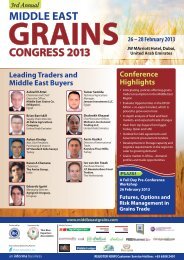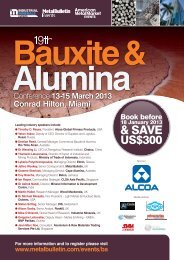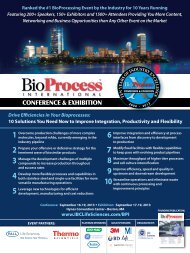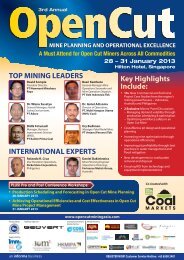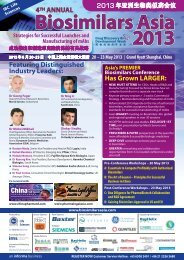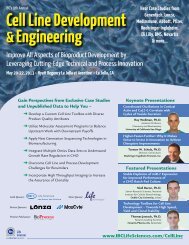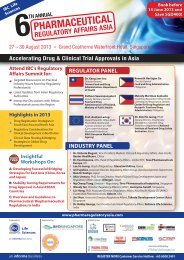The Industry's Preeminent Event on Novel Drug Targets ...
The Industry's Preeminent Event on Novel Drug Targets ...
The Industry's Preeminent Event on Novel Drug Targets ...
Create successful ePaper yourself
Turn your PDF publications into a flip-book with our unique Google optimized e-Paper software.
Present a poster and save $50!<br />
Cambridge Healthtech Institute encourages<br />
attendees to gain further exposure by<br />
presenting their work in the poster sessi<strong>on</strong>s.<br />
To secure a poster board and inclusi<strong>on</strong> in the<br />
c<strong>on</strong>ference materials, your abstract must be<br />
submitted, approved and your registrati<strong>on</strong><br />
paid in full by August 16, 2013. Please see<br />
registrati<strong>on</strong> page for details.<br />
Reas<strong>on</strong>s you should present your research<br />
poster at this c<strong>on</strong>ference:<br />
• Your poster will be exposed to our<br />
internati<strong>on</strong>al delegati<strong>on</strong><br />
• Receive $50 off your registrati<strong>on</strong><br />
• Your poster abstract will be published in our<br />
c<strong>on</strong>ference materials<br />
• Your research will be seen by leaders from<br />
top pharmaceutical, biotech, academic and<br />
government institutes<br />
“In <strong>on</strong>e day I wrote more notes than<br />
in full week-l<strong>on</strong>g c<strong>on</strong>ferences. Truly<br />
the state-of-the-art science at CHI!”<br />
Assistant Professor, U. of C<strong>on</strong>necticut<br />
Get C<strong>on</strong>nected!<br />
Follow us <strong>on</strong> Twitter<br />
@DOTBost<strong>on</strong>13<br />
Join the Discovery<br />
On Target Group<br />
Maximize your experience<br />
<strong>on</strong>-site at Discovery On<br />
Target 2013!<br />
<str<strong>on</strong>g>The</str<strong>on</strong>g> Intro-Net offers you the opportunity<br />
to set up meetings with selected<br />
attendees before, during and after this<br />
c<strong>on</strong>ference, allowing you to c<strong>on</strong>nect<br />
to the key people you want to meet.<br />
This <strong>on</strong>line system was designed with<br />
your privacy in mind and is available<br />
<strong>on</strong>ly to registered sessi<strong>on</strong> attendees<br />
of this event. Registered c<strong>on</strong>ference<br />
attendees will receive more informati<strong>on</strong><br />
<strong>on</strong> accessing the Intro-Net in the<br />
weeks leading up to the event!<br />
Plenary Keynote Speakers<br />
Towards a Patient-Based <strong>Drug</strong> Discovery<br />
Stuart L. Schreiber, Ph.D., Director, Chemical Biology, Founding<br />
Member, Broad Institute of Harvard and MIT; Howard Hughes<br />
Medical Institute Investigator; Morris Loeb Professor of<br />
Chemistry and Chemical Biology, Harvard University<br />
Small-molecule drugs were originally discovered using<br />
compound-based drug discovery: opportunistic discovery<br />
of a biologically active compound, often a natural product<br />
(e.g., penicillin) followed by a search for a disease that might be treated with the<br />
compound. This remains a comm<strong>on</strong> approach to modern drug discovery (e.g.,<br />
rapamycin and analogs for use as antifungal agents; immune suppressi<strong>on</strong> agents;<br />
anti-cancer agents; possibly others in the future). <str<strong>on</strong>g>The</str<strong>on</strong>g> advent of recombinant<br />
DNA accelerated a sec<strong>on</strong>d approach – target-based drug discovery – where the<br />
therapeutic target is selected and subjected to methods that yield candidate drugs<br />
(mechanism-based design; structure-based design; screening). But this approach<br />
has its shortcomings – 97% of drug candidates that enter into clinical investigati<strong>on</strong><br />
eventually fail, many due to unanticipated toxicity and many others due to a lack of<br />
efficacy despite successful modulati<strong>on</strong> of the target. Selecting therapeutic targets<br />
based <strong>on</strong> informati<strong>on</strong> derived from surrogates of patients has proved challenging.<br />
Advances in human biology, including human genetics and physiology, and in smallmolecule<br />
science, including chemistry and chemical biology, are now accelerating<br />
a third approach – patient-based drug discovery. This lecture will present examples<br />
that aim to use: 1) informati<strong>on</strong> from heritable or somatic human genetics in human<br />
disease; for example, in Crohn’s Disease and cancer, 2) advances in diversityoriented<br />
synthetic chemistry and chemical biology to accelerate the discovery of<br />
safe and effective small-molecule therapeutics, and 3) an understanding of the<br />
relati<strong>on</strong>ship of human genetic variati<strong>on</strong> to drug efficacy.<br />
Enteroendocrine <strong>Drug</strong> Discovery for<br />
Treatment of Metabolic Diseases<br />
Paul L. Feldman, Ph.D., Senior Vice President,<br />
GlaxoSmithKline<br />
<str<strong>on</strong>g>The</str<strong>on</strong>g> Enteroendocrine Discovery Performance Unit at<br />
GlaxoSmithKline is focused <strong>on</strong> discovering and developing<br />
medicines that mimic the efficacy of Roux-en-Y gastric<br />
bypass surgery to treat metabolic diseases. Our strategy<br />
emanates from the findings that there are significant metabolic benefits to<br />
obese and obese diabetic patients that undergo Roux-en-Y gastric bypass<br />
surgery. In general, these patients experience ~30% weight loss while >80%<br />
of obese diabetics who undergo this surgery have complete “remissi<strong>on</strong>”<br />
of diabetes. Our strategy is focused <strong>on</strong> three areas: 1. enteroendocrine<br />
science: discovery efforts focused <strong>on</strong> targets expressed <strong>on</strong> the luminal<br />
surface of the GI tract and peptides secreted from the GI tract or other<br />
peptides known to have metabolic effects, 2. combinati<strong>on</strong> therapies: by first<br />
intent progress combinati<strong>on</strong>s of assets that work synergistically to manifest<br />
significant, differentiated metabolic efficacy, and 3. assets that minimize<br />
safety risks: peptide based therapeutics and GI luminally restricted small<br />
molecules. In this presentati<strong>on</strong>, I will describe the strategy our Unit has taken<br />
to discover novel combinati<strong>on</strong> peptide-based and GI luminally restricted small<br />
molecule therapeutics.<br />
MEDIA PARTNERS<br />
DiscoveryOnTarget.com 3




